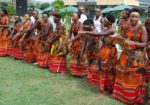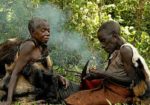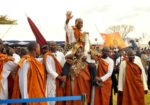Ankole, also referred to as Nkore, is one of the oldest traditional dynasties in Uganda. The Ankole kingdom is said to have been created way back in the early 15th century,
Originally, Ankole was known as Kaaro- Karungi and the word Nkore is said to have been adopted during the 17th century following the devastating invasion of Kaaro-Karungi by Chawaali, the then Omukama of Bunyoro-Kitara (Bunyoro-Kitara was one of the most powerful kingdoms in East Africa from the 16th to the 19th century).
On October 25, 1901 the word Ankole was introduced by British colonial administrators to describe the bigger kingdom which was formed by adding to the original Nkore, the former independent kingdoms of Igara, Sheema, Buhweju and parts of Mpororo by the signing of Ankole agreement.
The Ankole society was divided into two stratified castes the Bahima (nobility and pastoralists) and the Bairu (agriculturalists/peasants), who lived together peacefully and depended on each other.
The kingdom had a centralized administration system headed by the omugabe,(king) who came from the nobility Bahima clan, assisted by abakuru b’ebyanga (local chiefs) and an overall appointed enganzi (prime minister).
The people of Ankole Kingdom are called the Banyankole and they speak a language called Runyankole. The Banyankole are inhabits of the present-day districts of Mbarara, Bushenyi, Ntungamo, Kiruhura, Ibanda and Isingiro situated in western Uganda.
In Ankole, cattle were the most treasured possession in their lives; providing milk, ghee, beef and hides, cows were the state of the value and a medium of exchange. Cows were the mode of payment of bride price and some special cows were used in religious rituals as well as cultural and political ceremonies. The long horned Ankole cows were most valued because they were adapted to the climate of the region and resistant to most diseases. A cow was appreciated for the amount of milk it yielded: for its size and stature; its body color; and for the shape and whiteness of its long horns, as well as its ancestry.
Ankole people’s idea of Supreme Being was Ruhanga (creator). The abode of Ruhanga was said to be in heaven, just above the clouds, Ruhanga was believed to be the maker and giver of all things. It was, however, believed that the evil persons could use black magic to interfere with the good wishes of Ruhanga and cause ill- health, drought, death or even bareness in the land and among the people.
History of the Ankole Kingdom
Some scholars believe that Ankole originally was occupied by Bantu-speaking agricultural Bairu. Later, Ankole provided a passage for Hamitic peoples, possibly the Bahima, migrating from Ethiopia southward. These pastoralists conquered the Bairu and proclaimed themselves the rulers of the land. According to some scholars, the more numerous Bairu were serfs and the Bahima were the dominant ruling class. For the most part the two ethnic groups coexisted peacefully.
When the British created Uganda as a protectorate in 1888, Ankole was a relatively small kingdom ruled by a king (Mugabe) with supreme power. In 1901 the British enlarged the kingdom by merging it with the similarly small kingdoms of Mpororo, Igara, Buhweju, and Busongora. The power of the Omugabe was curtailed considerably once his kingdom was legally and constitutionally controlled. However, as the Omugabe of Ankole, the king was entitled to all the titles, dignities, and preeminence that were attached to his office under the laws and customs of Ankole. A political relationship based on serfdom, slavery, and clientship ceased to exist under British rule, and the Bairu became less marginalized and despised.
The pastoralist Hima (also known as Bahima) established dominion over the agricultural Iru (also known as Bairu) some time before the nineteenth century. The Hima and Iru established close relations based on trade and symbolic recognition, but they were unequal partners in these relations. The Iru were legally and socially inferior to the Hima, and the symbol of this inequality was cattle, which only the Hima could own. The two groups retained their separate identities through rules prohibiting intermarriage and, when such marriages occurred, making them invalid.
The Hima provided cattle products that otherwise would not have been available to Iru farmers. Because the Hima population was much smaller than the Iru population, gifts and tribute demanded by the Hima could be supplied fairly easily. These factors probably made Hima-Iru relations tolerable, but they were nonetheless reinforced by the superior military organization and training of the Hima.
The kingdom of Ankole expanded by annexing territory to the south and east. In many cases, conquered herders were incorporated into the dominant Hima stratum of society, and agricultural populations were adopted as Iru or slaves and treated as legal inferiors. Neither group could own cattle, and slaves could not herd cattle owned by the Hima.
Ankole society evolved into a system of ranked statuses, where even among the cattle-owning elite, patron-client ties were important in maintaining social order. Men gave cattle to the king (mugabe) to demonstrate their loyalty and to mark life-cycle changes or victories in cattle raiding. This loyalty was often tested by the king’s demands for cattle or for military service. In return for homage and military service, a man received protection from the king, both from external enemies and from factional disputes with other cattle owners.
The mugabe authorized his most powerful chiefs to recruit and lead armies on his behalf, and these warrior bands were charged with protecting Ankole borders. Only Hima men could serve in the army, however, and the prohibition on Iru military training almost eliminated the threat of Iru rebellion. Iru legal inferiority was also symbolized in the legal prohibition against Iru owning cattle. And, because marriages were legitimized through the exchange of cattle, this prohibition helped reinforce the ban on Hima-Iru intermarriage. The Iru were also denied highlevel political appointments, although they were often appointed to assist local administrators in Iru villages.
The Iru had a number of ways to redress grievances against Hima overlords, despite their legal inferiority. Iru men could petition the king to end unfair treatment by a Hima patron. Iru people could not be subjugated to Hima cattle-owners without entering into a patron-client contract.
A number of social pressures worked to destroy Hima domination of Ankole. Miscegenation took place despite prohibitions on intermarriage, and children of these unions (abambari) often demanded their rights as cattle owners, leading to feuding and cattle-raiding. From what is present-day Rwanda groups launched repeated attacks against the Hima during the nineteenth century. To counteract these pressures, several Hima warlords recruited Iru men into their armies to protect the southern borders of Ankole.
Marriage and Family
Marriage; By the time girls turned eight or nine, particularly among the Bahima, preparation for marriage began. They were no longer free to run and play without some form of control. Girls were mostly kept indoors, where they ate beef and millet porridge and were forced to drink milk in large quantity so that they would become fat. Being fat is associated with beauty, and the drinking of milk is said to contribute to one’s beauty. As soon as a girl’s breasts emerge, she is warned by her parents to abstain from sexual activities, which may lead to pregnancy and disgrace the family. In the past pregnancy outside marriage was punished by death or expulsion from the home.
A Munyankole father, occasionally assisted by his relatives, is obliged to get a wife for his son by paying the required bride-wealth. This consists of two cows, three goats, and some pots of beer among the Bairu; among the Bahima it may range from two to twenty cows, depending on how wealthy a person is.
A marriage may be arranged by the couple’s parents, or the boy may propose to the girl during adolescence. Once the bride-price has been paid, preparations for the wedding begin. On the wedding day the bride’s father slaughters a bull for food. Other forms of food and a considerable amount of beer are prepared for feasting at the bride’s home. This is followed by another feast at the bridegroom’s home, where the marriage is consummated. At the wedding ceremony the girl’s aunt confirms that the groom is potent and that the bride defended her virginity before the marriage was consummated.
A social distinction between the Bahima and the Bairu was established by prohibiting intermarriage between them. The Bahima would find it repugnant to marry a Mwiru. Moreover, it was illegal for a Muhima to give cattle to a Mwiru. A Mwiru would have no cattle for bridewealth for a Muhima wife since all he had was unproductive cows and bull calves. Cattle were essential not only for the legitimacy of marriage but also for the legitimacy of the children born out of a marital relationship.
A woman with no children has no status among the Banyankole, and most women wish to marry and raise many children. If a woman is unable to bear children, her husband is likely to contemplate taking a second wife. Monogamy was the standard practice, though polygamy was not prohibited. Both the Mugabe and wealthy Banyankole practiced polygamy. Today monogamy remains the predominant form of marriage, influenced by Westernization, Christianity, education, and the traditional Banyankole model.
Death and Afterlife
Among the Banyankole illness is not considered a natural cause of death; therefore, such deaths require an investigation to find the responsible party. By contrast, old age is accepted as a sufficient cause for death. It is held that God allows old people to die after the completion of their time on earth. The Banyankole view death as a passage to another world.
When a man dies, every relative, along with friends and neighbors, is informed. A person who fails to attend the funeral without a good reason may be suspected of being associated with the death. Before burial, the body is washed and the eyes are closed. As the deceased is placed in the grave, the right hand is placed under the head while the left hand rests on the chest. The body lies on the right side. One or more cows are slaughtered to feed everyone present. Beer is provided as part of the mourning. The mourning goes on for four days. A deceased woman is treated in a similar manner except that in the grave she is made to lie on the left side as if she were facing her husband. Her left hand is placed under her head, while her right hand rests on her chest.


